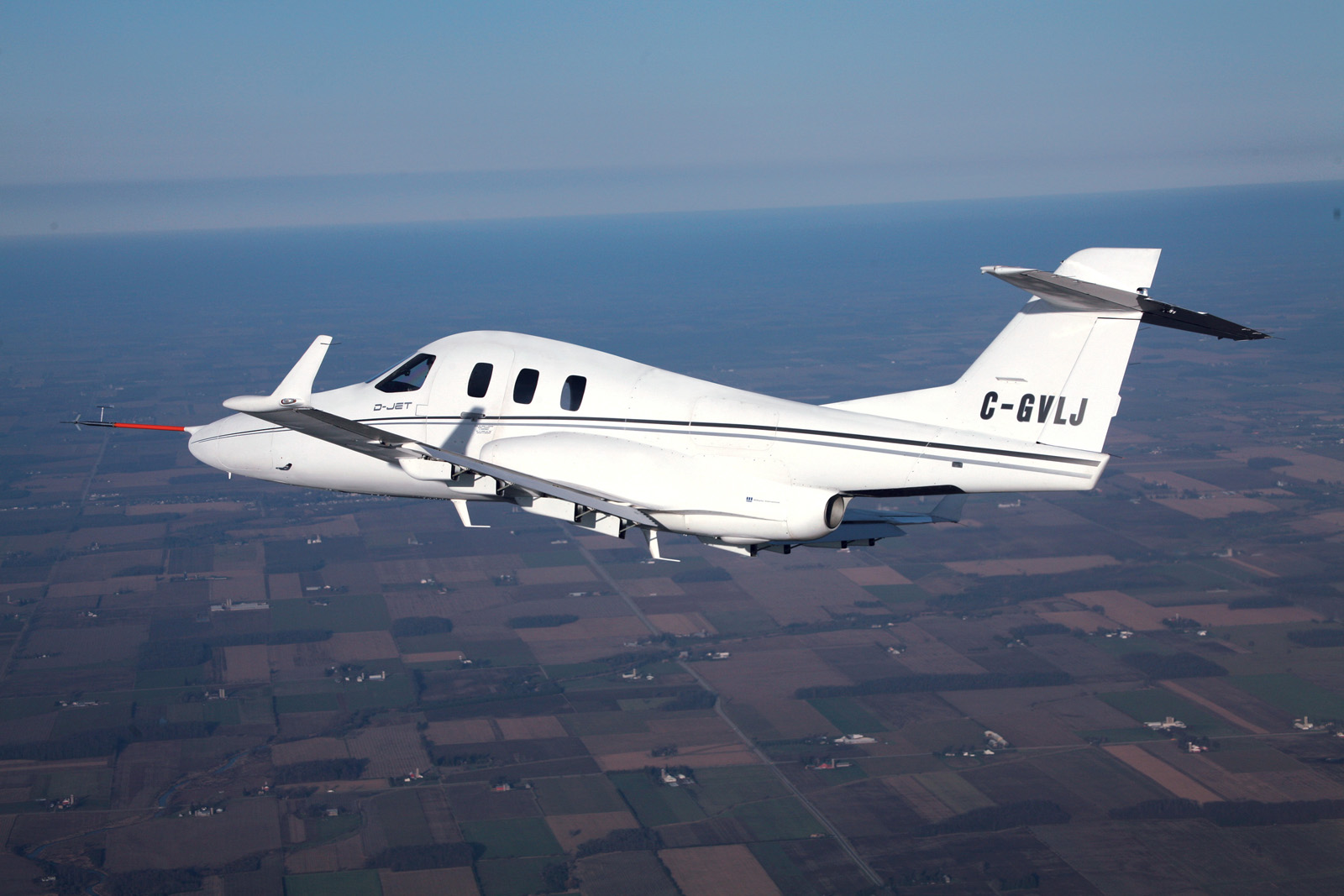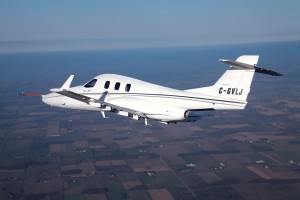By Jeff Mattoon
When Yehuda Netanel was growing up in Israel, he was no different than many, if not most young boys around the world; he had a dream to fly, but as is common in many countries, general aviation in Israel wasn’t available to the masses. The only way he could realize this dream was to join the Israeli air force. With an acceptance rate of about one out of a thousand, his odds weren’t great, and predictably, he didn’t make the cut.
At the age of 22, Netanel came to America with a different goal—to become an architect. This time he was successful in his pursuit, which led to the accomplishment of his dream of flying. Though it took him 13 years, he eventually realized that dream, earning his private pilot’s license when he was 33.
It didn’t take long to realize flying for business carried many benefits, including the unexpected.
“About 18 years ago, I was returning from Denver to the Los Angeles area, and while flying over Utah, I happened to notice a town that caught my eye as a very robust-looking place,” remembers Netanel. “It turned out to be St. George. I flew back a few days later, and what I discovered prompted me to search out properties for commercial development. That was one of my first commercial shopping centers.”
Bring on the jet
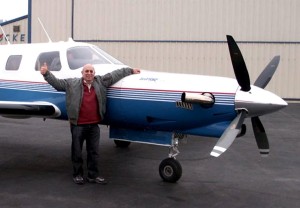
Yahuda Netanel retrofitted his Piper Malibu with a turbine engine for more power and increased reliability, and to familiarize himself with operating jet engines.
Now 55, Netanel, with more than 3,000 hours, has his instrument rating and his own Piper Malibu to traverse the country conducting business for his commercial development company. He likes to use both his architectural and aviation skills to benefit his business.
While he’s very pleased with his Malibu, Netanel was looking to the future about a year ago when he decided that using a jet was a better way to travel.
He decided he wanted the performance and ease of use new jet technology would bring. He also wanted a favorable delivery position, so Netanel made quick work of evaluating all the VLJ offerings, eventually deciding on the Diamond D-Jet.
“While I devote a lot of resources to flying, it’s not my occupation,” says Netanel. “I want to make sure there’s a balance between my flying and my personal life, so ease of operation is important. I don’t want to spend a lot of time learning a new aircraft, and I didn’t want to have to become a professional pilot to be able to fly a jet.”
Jean-Christophe (JC) Lemy, Diamond’s D-Jet director of sales and marketing, says the company wants the D-Jet to be easy to fly for the average pilot.

Yahuda Netanel is impressed with the layout of the D-Jet’s cockpit. He hopes to take delivery of his D-Jet in early 2009.
“We do not want this aircraft to be available only to professional pilot,” he said. “The D-Jet was designed from the start to be a personal, owner-flown light jet. This was the vision of Christian Dries (Diamond’s CEO and designer of the D-Jet) from the start.”
With a jet on the way, Netanel is preparing his skills. In addition to accumulating complex aircraft time, he went an extra step and converted his Malibu to a turbine-powered aircraft to have familiarity with jet engine systems. He feels stepping into the D-Jet will be a smooth transition.
“The D-Jet’s start system is more automated; its FADEC (Full Authority Digital Engine Control) is a huge leap in technology for aircraft of this size,” says Netanel. “Diamond is creating a plane that’s ideal for people like me who’ve accumulated some hours; we’re a few years older, but that’s not going to work against us with the insurance companies, because the aircraft will hopefully have predictable handling characteristics, just like other aircraft we’re used to already.”
The primary reason Netanel is singing the praises of the Diamond Aircraft D-Jet is found in the plane’s specific design, which serves a specific market. The D-Jet is a Williams FJ33-4 single-engine very light jet. Diamond prefers to label it a “personal” jet, something that ostensibly all single-engine jet manufacturers tend toward. What makes it appealing to pilots like Netanel is the single-engine-simplicity, to be sure, but there are other considerations.
The D-Jet is certified to a ceiling of 25,000 feet, something insurance companies like due to the increased reaction time as compared to higher flight levels. This is especially important in the event of unexpected and rapid depressurization.
At FL250, the average person gets about two minutes before unconsciousness. Just 5,000 feet higher, and you only get about 45 seconds to correct your situation before disaster.
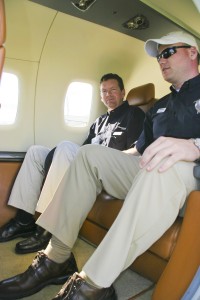
Diamond Aircraft representatives demonstrate how two tall men can be quite comfortable in the passenger cabin. Diamond states that the rear bench can seat three, but it appears it would be a friendly squeeze.
Another designed “limitation” deals with pressurization. Instead of the required eight psi pressurization for altitudes over 30,000 feet, the D-Jet only needs five-and-a-half psi, which offers some obvious and latent benefits.
“Because of the reduced pressurization, in terms of structure, we do not have to be as rigid as our competitors. Beneficially, we are able to design a larger cabin,” declares Lemy. “It is quite common for people who see the mock-up to comment that they did not expect so much room.”
“It’s like a Bentley!”
Netanel is quite satisfied with the interior accoutrements of the D-Jet interior.
“The impression is that you’re stepping into a Bentley,” he states.
Netanel uses his Malibu as the measuring stick. While the Malibu is somewhat roomy to begin with, Netanel looks forward to more space. As far as he’s concerned, that’s just the tip of the iceberg.
The passenger seating area consists of two “bucket” seats connected with a “third” seat between them. It’s really a bench, but the occupiers of each end seat will definitely receive a higher level of comfort. When you sit in the back of the D-Jet, you’re in no way reminded that it’s a very light (read small) jet—single engine or otherwise. There’s plenty of head, leg and hip room (as long as you’re not the third person sitting on the “hump”). In all fairness to Diamond, the hump is wider than most, but it certainly isn’t a “seat.” However, if one had to sit in the middle, it should still offer a pleasurable experience.
In terms of specs, you have a two-plus-three seating configuration—somewhat typical in VLJ’s and other light aircraft. However, the Diamond designers have pulled an ace out of their sleeves.
When not utilized for a safety pilot, the right front seat swivels around to make it a fourth club-style passenger seat, creating a one-plus-four. Bravo Diamond.
Not all insurability features of the aircraft have creature comfort benefits, but nonetheless, they are highly important to the transitional pilot.
What about insurance?
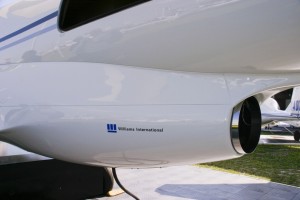
Williams International provides the D-Jet with the de facto VLJ standard FJ-33 power plant. Diamond claims that in the unlikely event of a catastrophic engine failure, flight characteristics of the D-Jet don’t change.
A few years ago, much of what was written about VLJs centered on increased pilot workload and increased speed. Many doubted whether pilots would, in fact, transition well enough to get the nod from insurance companies.
Many of those concerns have been abated. Although the D-Jet offers an impressive 315 knots true maximum cruise airspeed, its approach speed is around 80 ktas, and stall is in the low 60 knot range. This eliminates the need for air brakes, thrust reversers or any other devices that tend to increase pilot workload.
Pilot workload is also cleanly addressed in the application of the FADEC system, which offers single-lever control of the power plant. Diamond believes all these features of reduced ability will add up to decreased training requirements and increased insurability. This gives the pilot a less dangerous tool that is still quite capable compared to stout single engine and many light twin aircraft.
Adding to increased demand for the D-Jet, Diamond is proposing an offering of a “bumper to bumper” power-by-the-hour airframe warranty for $100 per hour, and Williams is offering an engine warranty for $50 per hour, which includes hot section inspection. This is something Diamond’s competitors have been reluctant to include. Lemy estimates operating cost to come in at around $300 per hour.
The China connection
Worldwide demand for the Diamond line of aircraft, including and especially the D-Jet, is on the increase. One place in particular that has shown overt signs of great interest in Diamond is China.
Diamond has exported aircraft to China for many years, but recently made an enormous commitment to the emerging market. Diamond, the Chinese government and private enterprise have built a 500,000-square-foot production facility in a joint venture that has Diamond quite optimistic about the Chinese aviation future.
“The Chinese are currently sending a lot of students overseas for pilot training,” says Peter Maurer, president of Diamond Aircraft. “They need a lot of pilots for airlines, and there’s a tremendous shortage, with respect to the expected growth.”
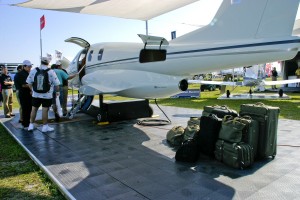
Wherever the D-Jet mock-up goes, it draws a crowd. As guests of this year’s Sun ‘n Fun tour the cabin, a pile of luggage illustrates the VLJ’s cargo capacity.
Lemy adds the reason China is so enthusiastic about general aviation now, whereas in the past it was very restrictive, is the realization that the path to being an airline pilot is through general aviation.
“Right now, China is crying for Chinese pilots, and allowing GA will solve this problem for them,” said Lemy.
Technology and technique are other exportable commodities, and Diamond is providing both to the Chinese.
“The most modern flight school I’ve ever seen is in Beijing,” says Maurer. “Beijing Pan Am operates a fleet of aircraft that are all Diamond and all glass cockpit G1000s. The singles are DA-40s and the twins are DA-42s. They also use our flight training devices from Diamond Simulation.”
An increased need for airline pilots in China isn’t the only issue fueling a Chinese aviation feeding frenzy. An old joke is at the root of the opportunity: What makes an airplane fly? Money.
“There are a lot of millionaires in China, but what has been impossible in the past is airline travel, because the military controlled the airspace,” says Maurer. “Successively, the military has begun allowing more and more air travel. First, you couldn’t fly at all, then you could fly only locally. Then you were able to fly from city to city. We expect it will continue to open up progressively. It’s still tightly controlled and you have to apply in advance for flight permits, and so forth, but that’s going to change rather rapidly.”
When asked about whether Diamond is concerned about past Chinese propensity for reverse engineering and knockoff manufacturing, Maurer suggests the upside benefits to both parties may decrease that risk.
“Because global certification procedures protect the company from this risk, we’re not very concerned,” he said. “Even within China, the joint venture agreement we have protects us. If we’re successful, they’re successful. Joint venture or no joint venture, my prediction is that, over time, the Chinese will manufacture their own aircraft. I won’t be surprised if those aircraft closely resemble Diamond aircraft.”
That may be the most realistic perspective.
Flying offers an Angel’s perspective
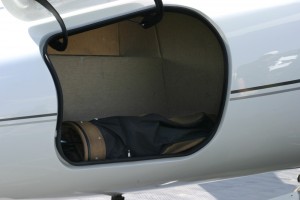
The D-Jet’s nose cargo hold comfortably cradles the obligatory set of golf clubs. Weight limitations notwithstanding, the nose compartment can easily carry four sets of clubs.
Perspective is something Yehuda Netanel has taken from his aviation experience.
“I’ve found in my life that the pursuit of flying gives you an ability to deal with life’s situations more easily, because pilots need to deal with a constant flow of changes,” he said. “We continuously evaluate and deal with an ever-changing set of circumstances. We also have to deal with the third dimension, which we normally don’t have to deal with in our life on terra firma.”
Dealing with life’s situations has given Netanel cause for pause and was motivation to get involved in the lives of others. In addition to flying extensively for business, Netanel also volunteers for Angel Flight. The not-for-profit organization arranges free air transportation on private aircraft in response to health care and other compelling human needs. The free service is available to those with illnesses, their families or medical personnel who need to travel to treat patients.
Netanel has participated for three years and has 40 missions to his credit.
“It gives you an emotional reason to fly and feel good about it,” he shared. “These are very rewarding flights and you feel like you’re contributing something to people who are less fortunate. It gives you a certain perspective and appreciation for what you have in life.”
Netanel looks forward to the day when he can offer Angel Flights in the D-Jet. The aviation future looks bright for Diamond Aircraft and Yehuda Netanel, as he waits for an estimated first quarter 2009 delivery of his Diamond D-Jet.
After a recent negative commercial traveling experience, Netanel’s wife says she’s much more content flying “Air Yehuda.”
For more information on Diamond Aircraft’s D-Jet, visit [http://www.diamondair.com]. For more information on Angel Flight, visit [http://www.angelflight.org].











